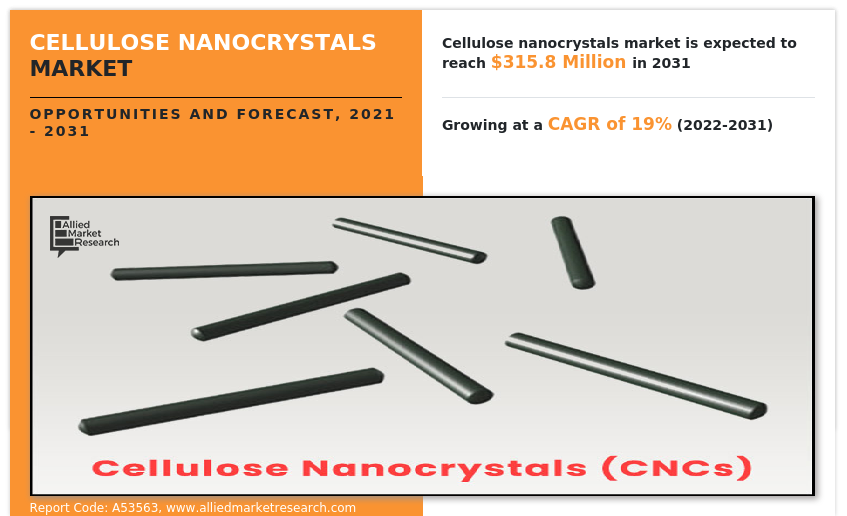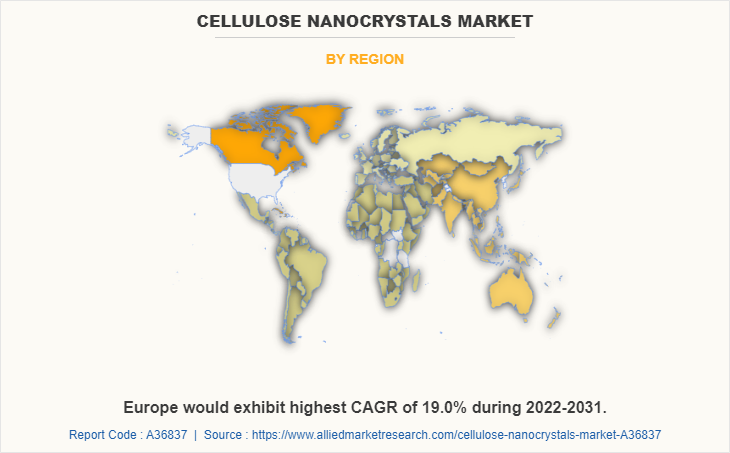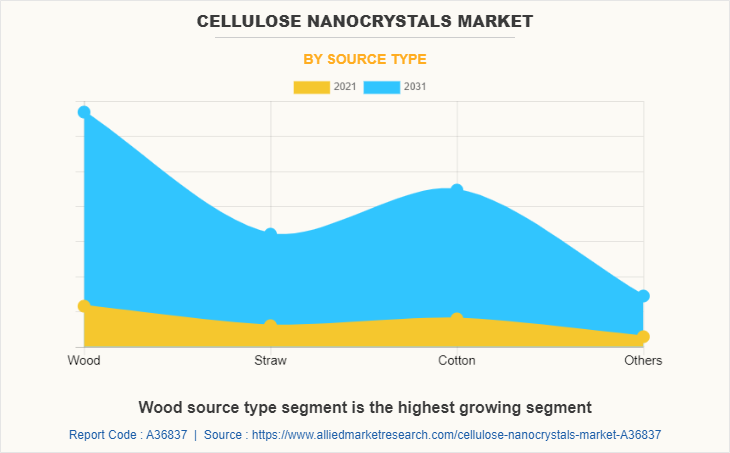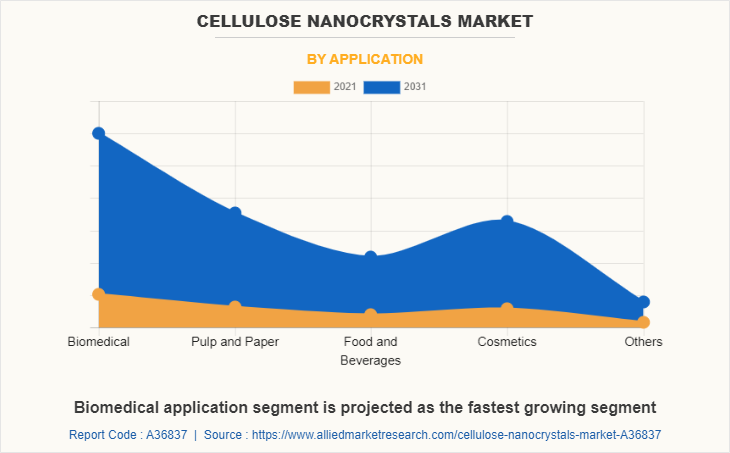Cellulose Nanocrystals Market Research, 2031
The global cellulose nanocrystals market size was valued at $55.7 million in 2021, and is projected to reach $315.8 million by 2031, growing at a CAGR of 19% from 2022 to 2031.
Report key highlighters:
- The report outlines the current cellulose nanocrystal market trends and future scenario of the market from 2022 to 2031 to understand the prevailing opportunities and potential investment pockets.
- The global cellulose nanocrystals market growth has been analyzed in terms of value ($Million) and volume (Tons). The analysis in the report is provided on the basis of source type, application, 4 major regions, and more than 15 countries.
- The cellulose nanocrystal industry is consolidated in nature with few players such as Anomera, Inc., Blue Goose Refineries, CelluComp, CelluForce, GranBio, innotech alberta, Kruger Inc., Melodea Ltd, Nanocrystacell, and Sappi, which hold significant share of the market.
- The report provides strategy planning and industry dynamics to enhance decision making for existing market players and new entrants entering the cellulose nanocrystal industry.
- Countries such as China, U.S., India, Germany, and Brazil hold a significant share in the global cellulose nanocrystal market.

Cellulose nanocrystals are unique nanomaterials are derived from the pulp of fibrous plant material, a natural polymer, cellulose, and other sources. The nanocrystal is a depolymerized cellulose obtained by treating alpha-cellulose with mineral acids and acid hydrolysis that consist of cylindrical, elongated, less flexible, and rod-like nanoparticles. It acts as an anti-caking agent, texturizer, emulsifier, and binding agent. Cellulose nanocrystal finds a wide range of applications in pharmaceuticals, food & beverages, cosmetics, pulp and paper, textiles, and other cellulose nanocrystals industry.
Nanocrystals of cellulose are chemical aggregates that can be combined to generate a crystalline form of medicine surrounded by a thin layer of surfactant. They have several applications in materials research, chemical engineering, quantum dots for biological imaging, and nanomedicine for medication delivery. Nanocrystals can also be stacked and put on flexible substrates to produce solar panels. They have also been utilized in the production of filters that convert crude oil into diesel fuel.
Robust demand from the pharmaceutical industry is projected to foster cellulose nanocrystal industry.
Key factors such as growing population coupled with advancements in technology, and a well-established pharmaceutical industry have enhanced the performance of the cellulose nanocrystal market. Cellulose nanocrystal is one of the most important excipients widely used in tableting due to their excellent binding properties in dry state. This may act as one of the key drivers responsible for the growth of the cellulose nanocrystal market in the growing pharmaceutical sector.
Furthermore, the growth of the global cellulose nanocrystal market is driven by an increase in demand for cellulose nanocrystals in the food processing industry in developing countries, such as China, India, and Brazil. The processed food industry has been using cellulose nanocrystals to produce low-fat dairy products, which is expected to boost the growth of the cellulose nanocrystal market.
High production cost and lack of technical expertise are expected to act as a challenging factor for the market.
However, increase in production, requirement for technical expertise, and the production cost of cellulose nanocrystals are expected to hinder the growth of the market. In addition, the availability of specific substitutes for cellulose nanocrystal such as carboxymethyl cellulose, kappa- carrageenan, and others are restraining the market growth.
The emergence of the skin care and cosmetic industry has enhanced the potential sales of the cellulose nanocrystal market.
On the contrary, rapid increase in the population in both developed & developing economies, rise in import & export of various cosmetics & skincare products, up-gradation in technology, and increased focus on the cosmetic sector have increased the demand for cellulose nanocrystals, where it is used as a texturizer and binding agent in the formulation of various skincare and personal care products such as liquid foundation, creams, makeup removal products, and others.
In addition, data published by the National Library of Medicine cellulose nanocrystals effectively solve post-make up skin cleansing problems. These factors are anticipated to offer remunerative opportunities for the cellulose nanocrystal market during the forecast period.
The cellulose nanocrystal market is segmented on the basis of source type, application, and region. By source type, it is bifurcated into wood, straw, cotton, and others. By application, it is divided biomedical, pulp and paper, food and beverages, cosmetics, and others. Region-wise, the market is studied across North America, Europe, Asia-Pacific, and LAMEA.
The major companies profiled in this report include Anomera, Inc., Blue Goose Refineries, CelluComp, CelluForce, GranBio, Innotech Alberta, Kruger Inc., Melodea Ltd, Nanocrystacell, and Sappi.

The Europe cellulose nanocrystals market share in 2021 was 40% in the global market and is projected to grow at the highest CAGR during the forecast period and Germany is a global leader in technical textiles in terms of both innovation and exports. It is one of the booming sectors in the Europe region. For instance, according to an article published by The Textile Magazine in March 2021, Germany is one of the largest importers of the textile and apparel (T&A) category with an import value of ~ $ 54 billion in 2019.
Germany exported textile worth US$ 39 billion in 2019, and the industry is growing at a CAGR (Compound Annual Growth Rate) of 6% from 2015 to 2019. Cellulose nanocrystal-containing polymer nanocomposites is also used for developing membranes, fibers, and textiles. These factors together increase the potential sales of cellulose nanocrystal in the European region.

In 2021, the wood segment was the largest revenue generator, and is anticipated to grow at a CAGR of 19.4% during the forecast period. This is attributed to the fact that, the utilization of wood-based cellulose nanocrystals has increased in the cosmetics, paper industry, food & beverages, and the pharmaceutical industry due to its excellent tissue substituent and binding agent. This may act as one of the key drivers responsible for the growth of cellulose nanocrystals in the wood-based segment.
The rise in population across the globe, increase in disposable income among people, and rapid shift in the consumer preference for several types of fruit juices & carbonated drinks have enhanced the performance of the food and beverages industry. It is widely used as a stabilizer, a low-calorie replacement for carbohydrate additives that are used as thickeners, flavor carriers, and suspension stabilizers during the production process of processed food. Wood-based cellulose nanocrystals can be consumed as a natural source of dietary fiber. This is projected to drive the growth of the wood-based cellulose nanocrystal market during the forecast period.

By application the market is divided into biomedical, pulp and paper, food and beverages, cosmetics, and others. The biomedical segment is dominating the global market, in terms of revenue in 2021 with 36% share in the global market. This is attributed to the fact that; the biomedical sector is one of the booming sectors across the globe. This is due to the rise in population, increase in R&D activities, advancement in technology, and surge in focus on the sector. For instance, according to an article published by Invest India in January 2023, India’s biotechnology industry crossed $80.12 billion revenue and growing 14% in 2022.
The dry binding properties of cellulose nanocrystal are used as a tissue substituent, antibacterial agents, and bioimaging agents. In addition, it is widely used in the pharmaceutical industry as a diluent in the formulation of drugs and capsules. These factors are expected to boost the overall demand for cellulose nanocrystals in the market. The major advantage of using cellulose nanocrystal is its binding capacity, chemical purity, and low reactivity. This is projected to drive the market growth in the coming years.
Key Market Trends
According to an article published by American Chemical Society, extraction of cellulose nanocrystals has obtained 88% of high yield by simultaneous mechanochemical activation and phosphotungstic acid hydrolysis process owing to which several key players are adopting this chemical process for obtaining high yield of cellulose nanocrystals. This key market trend is anticipated to boost the growth of the global cellulose nanocrystals market in the forthcoming years.
Key Recent Developments:
On August, 2021, Anomera Inc. developed a new product which is named carbonylated cellulose nanocrystal for cosmetic applications. This new product, promises to increase its regional economy, for a sustainable future, and for the cosmetics and personal care brands that are looking for an ingredient with the benefits of microbeads and biodegradability of cellulose nanocrystals. This strategic new product development is projected to expand the sales of cellulose nanocrystals in the North American region.
On March, 2020, Birla Carbon and GranBio Technolgies introduce innovation in Nanocellulose Dispersion Composite masterbatch. This introduction of masterbatch is helpful in the formation of rubber. This strategic innovation is projected to boost the sales of cellulose nanocrystals.
COVID-19 Impact Analysis:
The cellulose nanocrystal market suffered a moderate impact due to the wake of the COVID-19 pandemic. In addition, the increase in the number of COVID-19 patients during the pandemic made people purchase face masks, medications, and personal hygiene products on the e-commerce platform. Owing to which the potential sales of the cellulose nanocrystal market remained steady.
For instance, according to an article published by Express Pharma in August 2022, the Indian pharma hub has witnessed increased demand from across the globe for medical supplies and drugs. As a result, the Indian API market was valued at $11806.93 million (about $36 per person in the US) in 2021 and is expected to grow at a CAGR (Compound Annual Growth Rate) of 12.24% during the forecast period.
Cellulose nanocrystal-based membranes offer environmental solutions for aerosol filtration due to their biodegradability, renewability, biocompatibility, high specific surface area, non-toxicity, ease of functionalization and worldwide availability. Has spurred the cellulose nanocrystal market during the COVID-19. Furthermore, there is a decrease in the number of COVID-19 cases in the fourth quarter of 2020 owing to which there is a surge in the demand for personal care, consumer products, and hygiene-related products.
However, the consumption of nutritional syrup, capsules, and Vit d tablets is increased during COVID-19 owing to the health benefits associated with them. Cellulose nanocrystal is used for the formulations of various capsules, tablets, and drugs. Thus, the rising demand for health-beneficial products as well as packaged food is predicted to bolster the cellulose nanocrystal market during the forecast period.
Key Benefits For Stakeholders
- This report provides a quantitative analysis of the market segments, current trends, estimations, and dynamics of the cellulose nanocrystals market analysis from 2021 to 2031 to identify the prevailing cellulose nanocrystals market opportunities.
- The market research is offered along with information related to key drivers, restraints, and opportunities.
- Porter's five forces analysis highlights the potency of buyers and suppliers to enable stakeholders make profit-oriented business decisions and strengthen their supplier-buyer network.
- In-depth analysis of the cellulose nanocrystals market segmentation assists to determine the prevailing market opportunities.
- Major countries in each region are mapped according to their revenue contribution to the global market.
- Market player positioning facilitates benchmarking and provides a clear understanding of the present position of the market players.
- The report includes the analysis of the regional as well as global cellulose nanocrystals market trends, key players, market segments, application areas, and market growth strategies.
Cellulose Nanocrystals Market Report Highlights
| Aspects | Details |
| Market Size By 2031 | USD 315.8 million |
| Growth Rate | CAGR of 19% |
| Forecast period | 2021 - 2031 |
| Report Pages | 403 |
| By Source Type |
|
| By Application |
|
| By Region |
|
| Key Market Players | Sappi, Anomera, Inc., GranBio, CelluForce, innotech alberta, Nanocrystacell, Kruger Inc., Melodea Ltd, CelluComp, Blue Goose Refineries |
Analyst Review
According to CXOs of leading companies, the global cellulose nanocrystal market is expected to exhibit high growth potential. Cellulose nanocrystals are extracted from natural sources such as wood, sisal, cotton, straw, and others. It possesses chemical, physical, and rheological properties owing to which it is widely used in food & beverages, pharmaceuticals, and paper & pulp industry. It is an excellent source of binders, flavor enhancers, emulsifiers, abrasives, and extenders. The market is influenced by the inflated cost of raw materials and processing methods, thereby increasing the cost of cellulose nanocrystal. This factor is expected to impede the growth of the market. However, Asia-Pacific has witnessed significant adoption of cellulose nanocrystal in various industries such as food & beverages and cosmetics during the forecast period.
In addition, cellulose nanocrystal is used as texturizers in the growing textiles industry. Furthermore, factors such as flexibility in operation, ease of application, and sustainability have enhanced the performance of cellulose nanocrystal in several end-use industries. CXOs further added that sustained economic growth and development of the pharmaceutical sector have increased the popularity of cellulose nanocrystal.
Cellulose nanocrystals are unique nanomaterials are derived from the pulp of fibrous plant material, a natural polymer, cellulose, and other sources. The nanocrystal is a depolymerized cellulose obtained by treating alpha-cellulose with mineral acids and acid hydrolysis that consist of cylindrical, elongated, less flexible, and rod-like nanoparticles. It acts as an anti-caking agent, texturizer, emulsifier, and binding agent. Cellulose nanocrystal finds a wide range of applications in pharmaceuticals, food & beverages, cosmetics, pulp and paper, textiles, and others.
The Cellulose Nanocrystals Market valued for $55.7 million in 2021 and is estimated to reach $315.8 million by 2031, exhibiting a CAGR of 19% from 2022 to 2031.
Biomedical application is the leading segment in the cellulose nanocrystals market?
Anomera, Inc., Blue Goose Refineries, CelluComp, CelluForce, GranBio, Innotech Alberta, Kruger Inc., Melodea Ltd, Nanocrystacell, and Sappi.
The cellulose nanocrystal market is segmented on the basis of source type, application, and region. By source type, it is bifurcated into wood, straw, cotton, and others. By application, it is divided biomedical, pulp and paper, food and beverages, cosmetics, and others. Region-wise, the market is studied across North America, Europe, Asia-Pacific, and LAMEA
Europe holds largest regional market share for cellulose nanocrystal market.
Upgradation in the technology, increasing modernization in production techniques, and emergence of cosmetics and skin care industry are the upcoming trend in the global cellulose nanocrystal market.
Loading Table Of Content...



